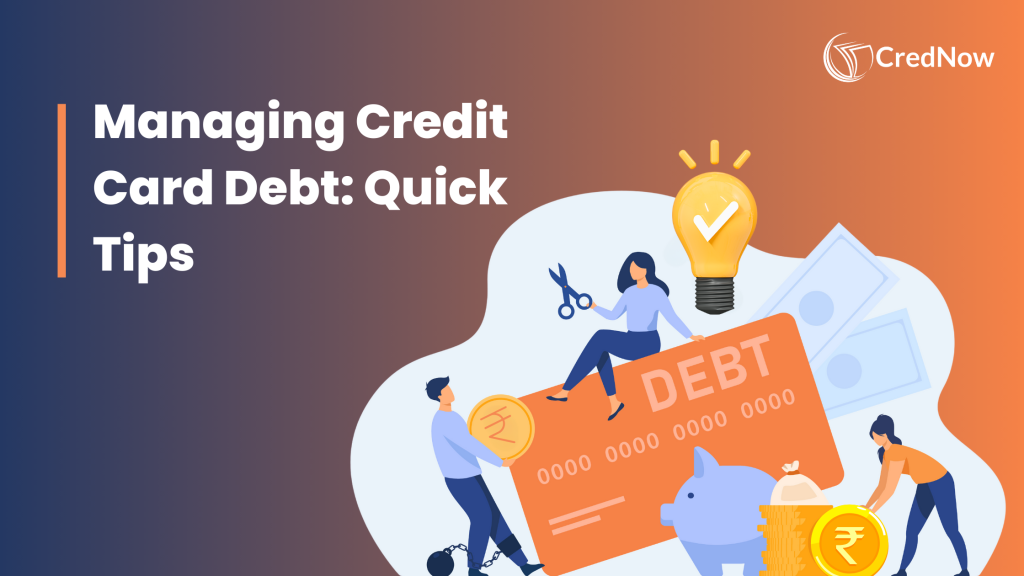Managing credit card debt can be overwhelming, but with the right strategies, it is entirely possible to regain control of your finances. This guide will provide practical tips to help you navigate and manage your credit card debt effectively. Let’s get started!
Understanding Credit Card Debt
According to recent data, the number of active credit cards in India reached almost 10 crore (100 million) by January 2024, marking an 81% increase from 2019. Along with the rise in the number of credit cards, credit card spending also hit a record high, with Indians spending nearly ₹1.72 lakh crore via credit cards in October 2023.
The average outstanding credit card balance in India has also seen substantial growth. The outstanding credit card balance of banks rose by 34% from the previous year, reaching ₹2.4 lakh crore by November 2023. This increase in credit card usage highlights the growing reliance on credit cards for both everyday purchases and larger expenses.
Common Causes of Credit Card Debt
In India, the causes of credit card debt are similar to those in other countries:
- Overspending: The ease of making purchases with credit cards can lead to overspending, particularly with the temptation of offers like no-cost EMIs.
- Unexpected Emergencies: Many individuals use credit cards to cover unexpected expenses, such as medical emergencies or urgent repairs.
- Lack of Budgeting: Without a proper budgeting plan, it’s easy to lose track of spending, leading to higher credit card balances that are difficult to pay off.
Impact of Credit Card Debt
The rise in credit card usage and debt in India is a double-edged sword. On one hand, it reflects increased financial inclusion and accessibility to credit. On the other hand, it has led to a significant rise in defaults. Credit card defaults in India stood at ₹4,072 crore in the financial year 2022-2023, a notable increase from ₹3,122 crore in the previous year (India Today). This trend has prompted the Reserve Bank of India (RBI) to closely monitor unsecured lending and credit card usage to mitigate potential financial stress.
Understanding these statistics and the dynamics of credit card debt is crucial for maintaining financial health. Responsible usage, regular payments, and budgeting can help manage and mitigate the risks associated with credit card debt.
Recommended Read: Master Your Credit Score and Boost Your Financial Health
Assessing Your Financial Situation
The first step in managing credit card debt is to assess your financial situation. Start by reviewing your credit card statements to understand your spending patterns. Calculate the total amount of debt you owe across all credit cards. It is also crucial to check your credit score, as it impacts your ability to negotiate better terms with creditors and qualify for lower interest rates.
Creating a Budget
A budget is a powerful tool for managing credit card debt. It helps you track your income and expenses, ensuring you live within your means. Here’s how to create an effective budget:
- List Your Income: Include all sources of income, such as your salary, allowances, freelance work, and any side hustles.
- Track Your Expenses: Record all your monthly expenses, including rent, fees, utilities, groceries, and discretionary spending.
- Identify Cutbacks: Look for non-essential expenses you can reduce or eliminate. This might include dining out less often, curtailing shopping, cancelling subscriptions, or cutting back on entertainment.
Developing a Repayment Plan
Once you have a budget, the next step is to develop a repayment plan. There are several strategies to consider:
- Debt Snowball (Incremental) Method: Focus on paying off your smallest debt first while making minimum payments on other cards. Once the smallest debt is paid off, move to the next smallest, and so on.
- Debt Avalanche (Priority) Method: Prioritize paying off debts with the highest interest rates first, which can save you more money on interest over time.
Set realistic goals with reminders and automate your payments to avoid missed payments and late fees. Automation ensures you stay consistent and reduces the stress of manual payments.
Negotiating with Lenders
Don’t hesitate to contact your credit card companies to negotiate better terms. Here are a few tips:
- Lower Interest Rates: Ask for a lower interest rate, which can significantly reduce the amount of interest you pay over time.
- Payment Plans: Inquire about setting up a payment plan that fits your budget.
- Debt Settlement Options: If you’re struggling to make payments, discuss debt settlement options where you may pay a lump sum that’s less than your total balance.
Avoiding Future Debt
To prevent falling back into debt, adopt smart spending habits:
- Live Within Your Means: Only charge what you can afford to pay off each month.
- Build an Emergency Fund: Save at least three to six months’ worth of living expenses to cover unexpected costs.
- Regularly Monitor Finances: Keep an eye on your credit card usage and overall financial health to catch any issues early.
Seeking Professional Help
If you’re overwhelmed, consider seeking professional help:
- Credit Counselling: Credit counselling agencies can provide guidance and help you create a simple debt management plan.
- Debt Management Plans: These plans consolidate your debts into one monthly payment, often at a lower interest rate.
- Legal Options: In extreme cases, you might need to consider legal options such as bankruptcy. However, this should be a last resort due to its long-term impact on your credit score.
Conclusion
Managing credit card debt requires discipline and a strategic approach, but it’s easily achievable. By understanding your debt, creating a budget, developing a repayment plan, negotiating with creditors, avoiding future debt, and seeking professional help when needed, you can take control of your financial future.
Remember, managing credit card debt is a journey. Celebrate small victories along the way and stay committed to your financial goals.
FAQ’s
1. What are the first steps I should take to start managing my credit card debt?
The first steps to managing credit card debt include assessing your financial situation, which involves reviewing your credit card statements, calculating your total debt, and checking your credit score. Next, create a detailed budget to track your income and expenses, identify areas where you can cut back, and allocate funds towards debt repayment.
2. What is the difference between the debt snowball and debt avalanche repayment methods?
The debt snowball method involves paying off your smallest debts first while making minimum payments on larger debts. This approach can provide quick wins and motivate you to continue. The debt avalanche method, on the other hand, focuses on paying off debts with the highest interest rates first, which can save you more money on interest over time. Choose the method that best suits your financial situation and psychological preference.
3. How can I negotiate better terms with my credit card issuer?
To negotiate better terms with your credit card issuer, start by contacting customer service and explaining your situation. You can ask for a lower interest rate, reduced fees, or a more manageable payment plan. Having a good payment history and being polite but persistent can increase your chances of success. It can also be helpful to research current offers from other issuers as leverage in your negotiations.
4. What should I do if I am struggling to make my credit card payments?
If you are struggling to make your credit card payments, contact your credit card issuer immediately to discuss your options. You may be able to negotiate a temporary payment plan, lower interest rates, or waived fees. Additionally, consider seeking help from a credit counselling agency, which can provide advice and assist in creating a debt management plan.
5. How can I avoid accumulating credit card debt in the future?
To avoid accumulating credit card debt in the future, adopt smart spending habits such as living within your means, using credit cards only for essential purchases, and paying off the balance in full each month. Additionally, build an emergency fund to cover unexpected expenses and regularly monitor your financial health to ensure you stay on track. Developing a disciplined approach to credit card



